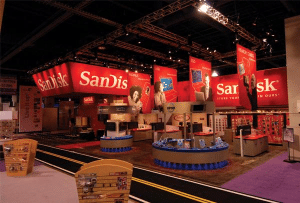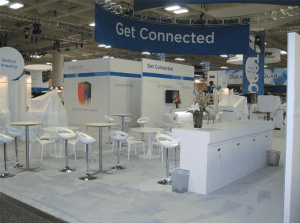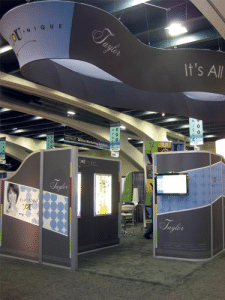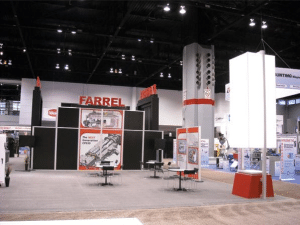Why Invest in Exhibition Displays, Anyway?
Let’s go back to the basics, for the moment – quality exhibition displays aren’t cheap. The economy is still struggling, and we’re all constantly looking for fat to trim from the budget. Why should you spend money going to trade shows? After all, good display stands start at about $1K, and even pop up banners can be a few hundred dollars.
The truth is, trade shows continue to be one of the most effective overall marketing techniques you can engage in, and are among the most efficient options for marketing a company’s product or services to a variety of reasonably qualified people, at the same time, in one place.
Exhibitors are poised to make sales during the show, meet important partners and contacts, earn leads, and attract more buyers to their organizations. There are a lot of different ways to derive benefit from trade shows, exhibition displays and pop up banners, depending what you’re looking to get out of them, and their popularity derives from how multi-purpose they are.
Although investing in trade show supplies can lead to many benefits, including closed deals and more customers, some exhibitors fare poorly during the show and recoup little to none of the cost.
Let’s review the situation from two perspectives – first, let’s look at what can go wrong at trade shows, and second, let’s review the many ways trade shows can contribute to the bottom line.
Three Killer Trade Show Marketing Mistakes.
1) Having Unrealistic Expectations and Unclear Objectives
Entering the trade show with the expectations of killing the competition and selling a year’s worth of wares—during the show— is unrealistic. At the same rate, expecting a large crowd of desperate and qualified prospects is a recipe for disappointment if attendees aren’t swarming into the event.
is unrealistic. At the same rate, expecting a large crowd of desperate and qualified prospects is a recipe for disappointment if attendees aren’t swarming into the event.
Designing exhibition displays and pop up banners so they inform attendees about your products or services and help to interest them in creating new relationships with your business is the first step, and will help prevent disappointment and unfavorable outcomes.
Companies should plan strategically when creating trade show displays, and a winning strategy is largely dependent on asking the right questions first and foremost. Failure to learn the following details prior to the show will most likely result in wasted time and little returns:
· What are the attendees interested in and can my company deliver?
· What makes my products or services different from the competing participants?
· Do we have the resources in place to handle a large influx of buyers or clients?
· Is a follow-up program in place for the leads obtained and interested future buyers?
· How can we leverage the results of the last show to increase success in this one?
· What benefits do we expect to gain from attending the show; sales, leads, or something else?
2) Failure to Market Prior to the Event
Trade shows are flooded with companies looking to lure customers with the latest products and services. With no shortage of competitors but a limited number of prospects, getting visitors to focus on your exhibition displays and pop up banners can be tough.
Spending large sums on huge, amazing display stands will bring in considerably less ROI if you don’t also invest in pre-event marketing. Attracting more qualified prospects to the event equals more potential customers visiting your exhibition displays. Participating in a trade show does not eliminate the need to market using traditional tools such as:
· Direct mail
· Television and radio advertising
· Print advertising
· Social media
· Internet advertising
Dedicating time and resources for pre-event marketing contributes to a higher return on investment and a more positive experience during the show.
3) Refusing to Try Different Strategies
Planning is the precursor to success with trade shows. Last year’s successful event does not necessarily equate to this year’s good fortune. All solid plans have room for testing and improvement; previous achievements can be used to create future successes and prior setbacks should be revisited for more clarity.
In addition, any strategies for new exhibition displays and pop up banners should be designed to create better results than the previous strategy, within the budget constraints. Taking a look at your previous results and studying the competition brings more bang for each marketing buck.
OK, now lets do a quick overview of the many ways investing in pop up banners and exhibition displays can pay off for you!
Ways Trade Shows can Help Your Business
1) Attract new customers and leads. This is easily the most common use of trade shows. Other companies and individuals alike look to trade shows to find new products and new businesses to partner with. In a single day or weekend, you can pick up enough leads to keep your sales team busy for months.
2) Look for employees. Granted, it’s very much a “buyer’s market” in employment at the moment, but trade shows can also be a great way to scout for new talent. If you’re looking for people with a serious interest and a high level of knowledge about your industry, trade shows are the place to go.
3) Get media exposure. Trade shows, especially the bigger ones, are often covered by both trade publications as well as the media at large. An impressive trade show display or product demonstration will get a huge push from this publicity, especially if it comes from a major outlet. Contact the media before you put up your pop up banners and exhibition displays to see if you can work up any interest in them visiting your trade show booth.
4) Keep an eye on the competition. Trade shows represent an odd detente in the overall information arms race in the business world: Once or twice a year, everyone in an industry lays (most of) their cards on the table and shows what they’ve got. You can glean a lot of valuable insight into your competitions’ aims and strategies through careful observation of their exhibition displays, pop up banners, and all the products and videos that they are promoting.
5) Increase brand awareness. Sometimes trade shows can be about positioning as well as selling. If you’re wanting to increase awareness or change public perception of your company, pop up banners or exhibition displays with a specific targeted message – such as how eco-friendly you are, or how innovative your production processes are – can create great PR.
6) Educating dealers or other associates. Trade shows also offer a good opportunity to meet face-to-face with your dealers and other business partners, to keep them up to date on your current standards and training techniques. Getting a lot of them in one place will help you ensure everyone is on the same page and that your product is being promoted in a standardized fashion.
7) Trade shows are tax-deductible. While tax matters are always subject to change, at least at the moment, investments in exhibition displays, pop up banners, and other trade show supplies can be immediately expensed on your taxes, making them a much more attractive investment overall.
By refusing to make the same mistakes as other marketers with trade show displays, a company is one step closer to creating pop up banners and exhibition displays that attract more prospects and leads. By having clear expectations that align with the capabilities of your products or services and marketing to qualified prospects well in advance of the show, your trade show marketing efforts will continue to payoff—with financial payouts.
The key takeaway here is that there really are a large number of ways you can leverage trade show displays to promote your business. This makes the overall expense of investing in pop up banners and exhibition displays a lot easier to justify, and opens up multiple new avenues for you to promote your brand.
We also have tips for if they didn’t notice your trade show display and what to do when the trade show must go on.
